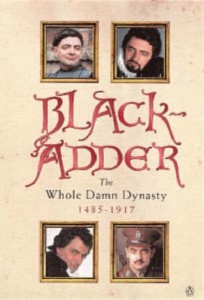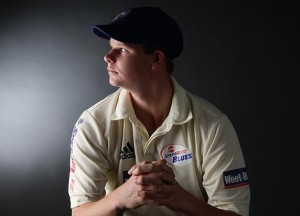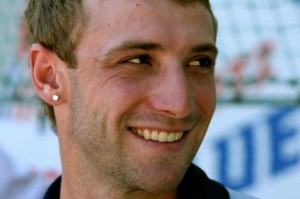
A gradual but inevitable descent into cricket-based loathing and bile.
Sheffield Shield Season 2013/4 Review: Moving Australia’s Drinks Cabinet Six Inches Closer To Berlin
Cast your mind back to those moments that immediately followed the Lord’s Test of the 2013 Ashes. In those dark (or bright, depending on your viewpoint) days Australian cricket was declared as being if not very nearly dead, then very actually dead. Most fingers were pointed in the general direction of Pat Howard, whose job title of General Manager of Team Performance (whatever the hell that means) could easily have been changed to General Scapegoat for Pretty Much Anything You Can Think Of. Pat, however, didn’t let his detractors get it all their own way. He hit back, claiming that he had a cunning plan, and that would solve everything by ‘fixing the Sheffield Shield’.
This caught most onlookers by surprise, not because Cricket Australia claimed to have an actual plan (one other than climbing out of the trenches and walking very slowly towards the enemy, which was pretty much their approach to facing Graeme Swann at the time) but because most people simply assumed Cricket Australia didn’t even know the Sheffield Shield existed. Needless to say, most were not convinced. Fast forward to the present though, and it seems Pat might have been on the right track after all. He bloody well went and fixed the Sheffield Shield. Or did he? Well, that’s what we are here to figure out. That and shamelessly steal even more material from Blackadder to hide the fact we are incapable of coming up with anything remotely original. Baaaa.

The 51allout guide to article writing; take this book, add a few pictures of Devereux, and you’re done!
Howard’s plan was simple: get rid of result pitches, green-tops cynically prepared to ensure an outright result within four days (he thankfully seemed to forget about his ‘five-day Shield games’ idea). Did it work? Well the fact that the most ruthless exponent of the practice, Tasmania, didn’t reach the final for the first time since 2009/10 suggests it did. Hooray for easy solutions!
Its success can be measured in other areas too. That an actual honest to God spinner (Stephen O’Keefe) topped the wickets table was a revelation. Johan Botha finished in the top five as well, with 36 scalps. There were other encouraging signs with the ball too. Chadd Sayers backed up from taking 48 wickets the previous season with 36 in this, suggesting he might be the real deal. James Behrendorff had a breakout season too. Luke Butterworth’s tally, however, plummeted from 45 the season before to 17, suggesting he is probably just a green track bully.
But it is runs that the Australian selectors are most interested in. Australia has a heap of promising fast bowlers, but barely any proven run scorers. On the surface this year’s Shield competition was a success on that front too. In the previous season’s competition only nine batsmen averaged over 40 (removing players who only played a couple of innings). The season before that, 20 players did. This time round 25 did, and of those, 13 averaged over 50. A pretty marked improvement. But does that mean Australia’s batting stocks can now be considered to be overflowing? Are they now on the verge of dominating Test cricket again for next decade? Let’s look at the numbers a little closer.
Of those 25 players, five (Warner, Devereux, Clarke, Rogers and Haddin) are already in the Test setup. A further three are probably not in the frame for Test selection (Marcus North, David Hussey, and Tom Cooper). The first two on account of age (and now in North’s case, retirement), the third because he is Dutch. Well, kinda Dutch. Whatever – but more of him later. Of those that are left, three are, at least nominally, wicketkeepers (Ryan Carters, Sam Whiteman, and Phil Nevill). That leaves 14 batsmen left to consider.

Picture of Devereux? Check.
The standout player was Peter Forrest, who scored 823 runs at an average of 68.58. Below him is Chris Lynn (587 at 58.7), Adam Voges (769 at 54.92), Callum Ferguson (565 at 56.5), Phil Hughes (597 at 54.27) Usman Khawaja (551 at 50.09), Rob Quiney (680 at 48.57), Joe Burns (563 at 46.91) and Glenn Maxwell (544 at 45.33). The only player in that group yet to represent Australia at international level is also the youngest (at 24) – Burns. All the rest are either currently representing Australia in limited overs cricket, or have been tried and dispensed with in the recent past.
Which means that it is likely that the next batsman selected for inclusion in the Test setup will have followed the tried and proven path (in Australian cricket at least) of being selected for national honors at a young age, then dropped and sent back to domestic cricket to prove himself before being selected again. Unless Joe Burns is the next big thing in Australian cricket (and some people argue that he is), or the selectors decide to take a punt on Tom Cooper (which is not entirely implausible) the next man promoted into the Australian batting order will probably be a fairly familiar face. Not that there is anything wrong with that; sending players back to earn their spurs on the domestic scene has long been established practice in Australian cricket. It just means that there are no real standout young players waiting in the wings, ready to take Test cricket by storm.
At the moment the upward trajectory of Australia’s international teams doesn’t seem to be matched by similar developments in its domestic ranks. Those of you who might be petrified at the prospect of another decade of Australian cricketing domination can probably rest easy for a little while yet. There is currently nothing to suggest that the players waiting on the fringes are any better than those already in the Test squad. Aside from Alex Doolan of course.
As a result, Australian cricket is currently playing a waiting game in regards to its batting talent. Fixing pitches in Shield cricket has led to some promising developments, but alongside those players who have pushed their way into Test contention a number (such as Ed Cowan, Jordan Silk, Mark Cosgrove, Nic Maddinson, and Aaron Finch) seem to have slipped further back. Coupled with the fact that a genuine wrist spinning talent remains as elusive as ever (James Muirhead played one Shield fixture this season, in which he went wicketless), Australian cricket still has a ways to go before it can consider itself back on its perch again. If forced to make a prediction, we would suggest that, after guys like Shaun Marsh and Phil Hughes, Joe Burns may be the next batsman the selectors have their eyes on right now. Moises Henriques’ century in the Shield Final will have raised his stock considerably as well, as performances in Shield Finals always get the selectors’ attention. Devereux’s century in the same game just further cemented what everyone pretty much already knows anyway; he will be the next Test captain, and may well be captaining the Australian T20 team before the end of the year.

Doing precisely what we’ve done eighteen times before is exactly the last thing they’ll expect us to do this time!
But otherwise there are slim pickings to be had on the domestic front, at least as far as batsmen are concerned. Darren Lehmann has quickly established a reputation of getting the very best out of what otherwise might seem an unremarkable group of players, but even he might struggle if required to repeat the trick continuously into the foreseeable future. And if he can’t, well, Australian cricket might find itself in a stickier situation than when Sticky the Stick Insect got stuck on a sticky bun.

1 Comment
Post a Comment
1
Kyle
06 Apr 2014 11:25
good article and good analysis. you’re right, batting pickings are slim.